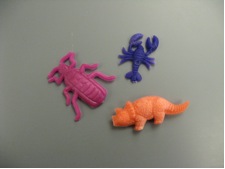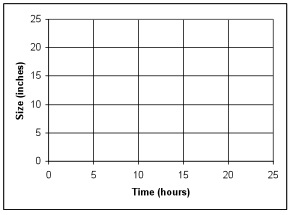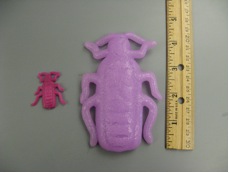Swelling Creatures
Water-absorbing polymer creatures can be obtained through the internet from companies such as Oriental Trading Company. These toys can be given to students to conduct the experiment at home, or you can perform the experiment in the classroom over the length of a week. The point of the experiment is to determine how much the creature grows when placed in water!

Supplies needed:
- Printed Worksheet
- Growing creature
- Ruler
- Water
- Large bowl
Procedure:
- Measure your creature's size with the ruler (length, width or both).
- Create a table/spreadsheet that includes size (in inches or millimeters) and amount of time immersed in water.
- Place the creature in the bowl of water.
- Wait an hour and measure it again. Record the measurement on your table/spreadsheet.
- Measure the size of the creature every few hours, and then measure it the next day. Record all values.
- Create a plot with all the data collected. Use "time" as the x-axis, and "size" as the y-axis (see below).


After the creature stops growing (you can tell this from the measurements you have made over time), remove it from the water, measure its size one last time, and add it to the plot. From all the data you collected, you can calculate the rate of swelling (how fast it swells). Use the following equation.

You can also calculate the total size increase (in percentage) using the following equation.

Note how long it took to grow to its maximum size.
Let the creature dry out. You can measure the size as it shrinks. With this information you can calculate the rate that the polymer creature shrinks. Measure its size after it is completely dry. Did it return to its original size?
Students can repeat this experiment of swelling and shrinking many times. We call this process a reversible process.